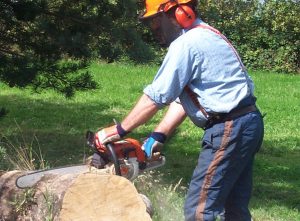A chainsaw is one of the most dangerous things you can buy. They can kick and move towards you – unlike other mechanical saws that stay in one place and you have to move towards to get hurt. All cutting surfaces are necessarily exposed, and they’re very mobile.
So safety is paramount – and that involves knowing the safety features of your chainsaw, using your chainsaw safely and wearing the correct safety gear.
The safety features can be seen below. The chain brake is an internal band brake that can either be manually applied or will self-apply in cases of kickback – this stops the chain instantly. The chain catcher is a little hook just in front of the sprocket on the base of the chainsaw that slows the chain down and catches it in cases of derailment or snapping. Don’t use a chainsaw that doesn’t have a chain catcher. The safety trigger is a form of ‘dead man’s handle’ (if you let go of the trigger, the chain stops) so it’s essential to have a good grip on the handle (to compress the dead man’s handle) before the trigger can be used.
Make sure the ‘off’ switch works. All the safety features will be covered in your training package.

The chain always runs forwards on the top of the guide bar, and so backwards (towards the user) on the bottom of the guide bar. The most dangerous part is where the chain starts to go round the nose – called the kickback zone. At the kickback zone, the cutter tries to grab too much wood and stops. This causes the machine to fly backwards violently towards the operator. So you use the bottom to cut, not the nose (unless you are extremely skilled).
Also, you can buy a low-vibration and anti-kickback chain. It’s much safer to have this – ask when you purchase a chainsaw or a new chain.
You’ll need safety gear, which includes:
Chainsaw boots or wellies (all chainsaw safety clothing carries a chainsaw logo). They will have a steel toecap, but also a chain-clogging fibre layer that will stop a chain if cut into. Steel toecaps alone could make the chainsaw spin off and cut your foot or leg in another place.
Chainsaw trousers (or bib and brace). Type A have front protection, including groin, and Type C have all-round protection (we don’t know what happened to type B, but there isn’t one). NB: all-round chainsaw trousers can get very hot in warm weather. For each type there is also a class, which relates to the thickness of the chain clogging fibre – class one is for chain speeds of up to 20m/s, class two is for speeds of up to 25m/s and class three is for chain speeds over 25m/s. For chain speeds, check the manual or ask your dealer.
Chainsaw gloves. There is a chain-clogging fibre layer on the back of the left-hand glove, which will be at the front end during use – nearer to the chain (as mentioned before, unfortunately for you left-handers, there’s no such thing as a left-handed chainsaw).
Helmet with visor and earmuffs. The official guidance is to change every three years, as the plastic can degrade and the visor can get holes in it.
And of course, not wearing safety gear invalidates your insurance.
Finally – and not trying to sound alarmist here, but preparing for a worst-case scenario – make sure you have a first aid kit nearby when you’re chainsawing, including large wound dressing.
 See here on the Health & Safety Executive website – a series of guides to safety, training and use of chainsaws, on the ground and in trees produced by the Arboricultural & Forestry Advisory Group.
See here on the Health & Safety Executive website – a series of guides to safety, training and use of chainsaws, on the ground and in trees produced by the Arboricultural & Forestry Advisory Group.

